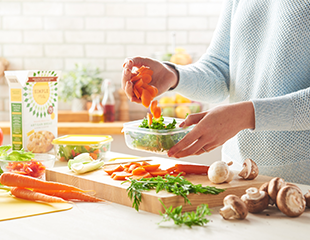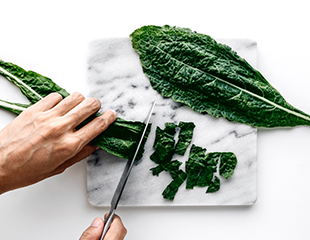What is the “Plant-Forward” Trend?
.png.aspx)
Adapting a plant-forward lifestyle means focusing on plant-derived, whole foods that are unrefined and minimally processed. Think foods like fresh fruit, nuts, seasonal vegetables, seeds and whole grains. Following a plant-forward lifestyle does not mean you can never eat meat again. On the contrary, foods like beef, chicken, pork and wild caught seafood can easily fit into a plant-based lifestyle, but in a supporting role as opposed to the main event. When creating a plant-forward meal, think of vegetables and whole grains as the main entrees and any animal protein as a side.
The Importance of Plants
Not only do plants taste delicious, but they host a variety of benefits that can help you
feel your best. A plant-forward lifestyle doesn’t mean abandoning your favorite recipes, instead simply refocus your attention on plants and put them first.
Fiber. Plant-based foods are full of
fiber. Fiber helps keep you satiated, which means you will feel fuller longer. Certain plant-based foods like apples, asparagus, nuts, and seeds also act as
prebiotics and provide fuel for the good bacteria living within our gut. This in turn helps keep our digestion running smoothly.
Phytonutrients.
Phytonutrients are responsible for a plant’s bright color, smell and taste, and plant-based foods contain them.
Vitamins, Minerals and Antioxidants. Plants contain an array of
vitamins and minerals. For instance,
dark leafy greens like broccoli, kale and spinach all contain Vitamins E and K and also have minerals like calcium and magnesium, so instead of shopping for more multivitamins, fill your plate with plants.
How You Can Focus on Eating More Plants

If you don’t want to ditch animal protein completely, ease into a plant-forward lifestyle instead. Here are five ways you can eat more plants every day.
#1 Add Plants to Your Smoothie
If you don’t enjoy vegetables on their own, add them to your smoothies. Include a cup of cauliflower, kale or spinach to your favorite
smoothie or smoothie bowl for an added dose of daily greens.
#2 Get Some Grains
Hearty whole grains make a great base for homemade bowls,
curries, side dishes and stews. Try amaranth, brown rice, buckwheat, millet or quinoa.
#3 Go Nuts for Nuts and Seeds
Nuts and seeds are a great on-the-go snack when practicing a plant-forward lifestyle. Almonds, Brazil nuts, cashews, chia seeds, flax seeds, hemp seeds, macadamia nuts, pumpkin seeds, sunflower seeds, and walnuts are all great options. Add some variety by choosing a new nut butter flavor to slather on a slice of fresh fruit or drizzle a spoonful on your stack of
superfood pancakes.
#4 Pile On the Plants
When whipping up your favorite dishes like homemade burrito bowls, pasta,
pizza and
tacos, take advantage of additional toppings by piling on the plants. You can even get creative and use vegetables to create veggie noodles from carrots and zucchinis. You may even bake up a
pumpkin pizza crust for your favorite flatbread recipe and serve vegetables in your favorite desserts like these
Secret Spinach Brownies.
#5 Serve Up Salads, Soups and Stir Frys
Eating more plants can be easy when you are whipping up a
handcrafted sandwich, salad, soup or stir fry. These meals are especially perfect if you are looking for a way to repurpose your leftover
food scraps.
Tag us
@SimpleMills and show us how you practice a plant-forward lifestyle.